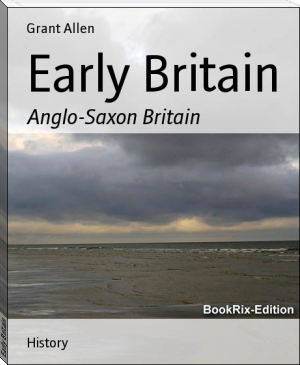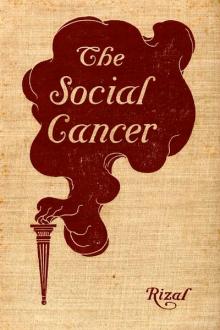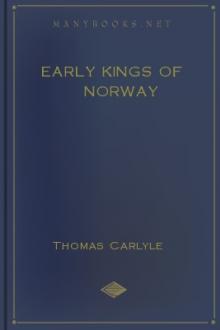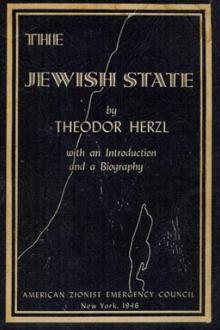Early Britain by Grant Allen (books recommended by bts TXT) 📕

- Author: Grant Allen
Book online «Early Britain by Grant Allen (books recommended by bts TXT) 📕». Author Grant Allen
clipped Norse form of Thor. Thursday is Thunor's day (Thunres dæg: dies Jovis) and the thunderbolt, really a polished stone axe of the aboriginal neolithic savages, was supposed to be his weapon. Thundersfield, in Surrey; Thundersley, in Essex; and Thursley, in Surrey, still preserve the memory of his sacred sites. Thurleigh, in Bedford; Thurlow, in Essex; Thursley, in Cumberland; Thursfield, in Staffordshire; and Thursford, in Norfolk, are more probably due to later Danish influence, and commemorate namesakes of the Norse Thor rather than the English Thunor.
Tiw, the philological equivalent of Zeus, answered rather in character to Ares, and had for his day Tuesday (dies Martis). Tiw's mere and Tiw's thorn occur in charters, and a few places still retain his name. Frea gives his title to Friday (dies Veneris), and Sætere to Saturday (dies Saturni). But the Anglo-Saxon worship really paid more attention to certain deified heroes,–Bældæg, Geat, and Sceaf; and to certain personified abstractions,–Wig (war), Death, and Sige (victory), than to these minor gods. And, as often happens in Polytheistic religions, there is reason to believe that the popular creed had much less reference to the gods at all than to many inferior spirits of a naturalistic sort. For the early English farmer, the world around was full of spiritual beings, half divine, half devilish. Fiends and monsters peopled the fens, and tales of their doings terrified his childhood. Spirits of flood and fell swamped his boat or misled him at night. Water nicors haunted the streams; fairies danced on the green rings of the pasture; dwarfs lived in the barrows of Celtic or neolithic chieftains, and wrought strange weapons underground. The mark, the forest, the hills, were all full for the early Englishman of mysterious and often hostile beings. At length the Weirds or Fates swept him away. Beneath the earth itself, Hel, mistress of the cold and joyless world of shades, at last received him; unless, indeed, by dying a warrior's death, he was admitted to the happy realms of Wælheal. As a whole, the Anglo-Saxon heathendom was a religion of terrorism. Evil spirits surrounded men on every side, dwelt in all solitary places, and stalked over the land by night. Ghosts dwelt in the forest; elves haunted the rude stone circles of elder days. The woodland, still really tenanted by deer, wolves, and wild boars, was also filled by popular imagination with demons and imps. Charms, spells, and incantations formed the most real and living part of the national faith; and many of these survived into Christian times as witchcraft. Some of them, and of the early myths, even continue to be repeated in the folk-lore of the present day. Such are the legends of the Wild Huntsman and of Wayland Smith. Indeed, heathendom had a strong hold over the common English mind long after the public adoption of Christianity; and heathen sacrifices continued to be offered in secret as late as the thirteenth century. Our poetry and our ordinary language is tinged with heathen ideas even in modern times.
Still more interesting, however, are those relics of yet earlier social states, which we find amongst the Anglo-Saxons themselves. The production of fire by rubbing together two sticks is a common practice amongst all savages; and it has acquired a sacred significance which causes it to live on into more civilised stages. Once a year the needfire was so lighted, and all the hearths of the village were rekindled from the blaze thus obtained. Cattle were "passed through the fire" to preserve them from the attacks of fiends; and perhaps even children were sometimes treated in the same manner. The ceremony, originally adopted, perhaps, by the English from their Celtic serfs, still lingers in remote parts of the country, as the lighting of fires on St. John's Eve. Tattooing the face was practised by the noble classes. It seems probable that the early English sacrificed human victims, as the Germans certainly did to Wuotan (the High Dutch Woden); and we know that the practice of suttee existed, and that widows slew themselves on the death of their husbands, in order to accompany them to the other world. Even more curious are the vestiges of Totemism, or primitive animal worship, common to all branches of the Aryan race, as well as to the North American Indians, the Australian black fellows, and many other savages. Totemism consists in the belief that each family is literally descended from a particular plant or animal, whose name it bears; and members of the family generally refuse to pluck the plant or kill the animal after which they are named. Of these beliefs we find apparently several traces in Anglo-Saxon life. The genealogies of the kings include such names as those of the horse, the mare, the ash, and the whale. In the very early Anglo-Saxon poem of Beowulf, two of the characters bear the names of Wulf and Eofer (boar). The wolf and the raven were sacred animals, and have left their memory in many places, as well as in such personal titles as Æthelwulf, the noble wolf. The boar was also greatly reverenced; its head was used as an amulet, or as a crest for helmets, and oaths were taken upon it till late in the middle ages. Our own boar's head at Christmas is a relic of the old belief. The sanctity of the horse and the ash has been already mentioned. Now many of the Anglo-Saxon clans bore names implying their descent from such plants or animals. Thus a charter mentions the Æscings, or sons of the ash, in Surrey; another refers to the Earnings, or sons of the eagle (earn); a third to the Heartings, or sons of the hart; a fourth to the Wylfings, or sons of the wolf; and a fifth to the Thornings, or sons of the thorn. The oak has left traces of his descendants at Oakington, in Cambridge: the birch, at Birchington, in Kent; the boar (Eofer) at Evringham, in Yorkshire; the hawk, at Hawkinge, in Kent; the horse, at Horsington, in Lincolnshire; the raven, at Raveningham, in Norfolk; the sun, at Sunning, in Berks; and the serpent (Wyrm), at Wormingford, Worminghall, and Wormington, in Essex, Bucks, and Gloucester, respectively. Every one of these objects is a common and well-known totem amongst savage tribes; and the inference that at some earlier period the Anglo-Saxons had been Totemists is almost irresistible.
Moreover, it is an ascertained fact that the custom of exogamy (marriage by capture outside the tribe), and of counting kindred on the female side alone, accompanies the low stage of culture with which Totemism is usually associated. We know also that this method of reckoning relationship obtained amongst certain Aryan tribes, such as the Picts. Traces of the ceremonial form of marriage by capture survived in England to a late date in the middle ages; and therefore the custom of exogamy, upon which the ceremony is based, must probably have existed amongst the English themselves at some earlier period. Even in the first historical age, a conquered king generally gave his daughter in marriage to his conqueror, as a mark of submission, which is a relic of the same custom. Now, if members of the various tribes–Jutes, English, and Saxons,–used at one time habitually to intermarry with one another, and to give their children the clan-name of the father, it would follow that persons bearing the same clan-name would appear in all the tribes. Such we find to be actually the case. The Hemings, for instance, are met with in six counties–York, Lincoln, Huntingdon, Suffolk, Northampton, and Somerset; the Mannings occur in English Norfolk and in Saxon Dorset; the Billings, and many other clans, have left their names over the whole land, from north to south and from east to west alike. It has often been assumed that these facts prove the intimate intermixture of the invading tribes; but the supposition of the former existence of exogamy, and consequent appearance of similar clan-names in all the tribes, seems far more probable than such an extreme mingling of different tribesmen over the whole conquered territory.[1] Part of the early English ceremony of marriage consisted in the bridegroom touching the head of the bride with a shoe, a relic, doubtless, of the original mode of capture, when the captor placed his foot on the neck of his prisoner or slave. After marriage, the wife's hair was cut short, which is a universal mark of slavery.
[1] I owe this ingenious explanation to a note in Mr. Andrew
Lang's essays prefixed to Mr. Holland's translation of
Aristotle's _Politics_. He has there also suggested the
analysis of the clan names for traces of Totemism, whose
results I have given above in part.
Thus we may divide the early English religion into four elements. First, the remnants of a very primitive savage faith, represented by the sanctity of animals and plants, by Totemism, by the needfire, and by the use of amulets, charms, and spells. Second, the relics of the old common Aryan nature-worship, found in the reverence paid to Thunor, or Thunder, who is a form of Zeus, and in the sacredness of hills, rivers, wells, fords, and the open air. Third, a system of Teutonic hero or ancestor-worship, typified by Woden, Bældæg, and the other great names of the genealogies, and having its origin in the belief in ghosts. Fourth, a deification of certain abstract ideas, such as War, Fate, Victory, and Death. But the average heathen Anglo-Saxon religion was merely a vast mass of superstition, a dark and gloomy terrorism, begotten of the vague dread of misfortune which barbarians naturally feel in a half-peopled land, where war and massacre are the highest business of every man's lifetime, and a violent death the ordinary way in which he meets his end.
CHAPTER IX.
THE CONVERSION OF THE ENGLISH.
It was impossible that a country lying within sight of the orthodox Frankish kingdom, and enclosed between two Christian Churches on either side, should long remain in such a state of isolated heathendom. For to be cut off from Christendom was to be cut off from the whole social, political, intellectual, and commercial life of the civilised world. In Britain, as distinctly as in the Pacific Islands in our own day, the missionary was the pioneer of civilisation. The change which Christianity wrought in England in a few generations was almost as enormous as the change which it has wrought in Hawaii at the present time. Before the arrival of the missionary, there was no written literature, no industrial arts, no peace, no social intercourse between district and district. The church came as a teacher and civiliser, and in a few years the barbarous heathen English warrior had settled down into a toilsome agriculturist, an eager scholar, a peaceful law-giver, or an earnest priest. The change was not merely a change of religion, it was a revolution from a life of barbarism to a life of incipient culture, and slow but progressive civilisation.
So inevitable was the Christianisation of England, that even while the flood of paganism was pouring westward, the east was beginning to receive the faith of Rome from the Frankish kingdom and from Italy. It has been necessary, indeed, to anticipate a little, in order to show the story of the conquest in its true light. Ten years before the heathen Æthelfrith of Northumbria massacred the Welsh monks at Chester, Augustine had brought Christianity to the people of Kent.
In 596, Gregory the Great determined to send a mission to England. Even before that time, Kent had been in closer union with the Continent than any other part of the country. Trade went on with the kindred Saxon coast of the Frankish kingdom, and
Tiw, the philological equivalent of Zeus, answered rather in character to Ares, and had for his day Tuesday (dies Martis). Tiw's mere and Tiw's thorn occur in charters, and a few places still retain his name. Frea gives his title to Friday (dies Veneris), and Sætere to Saturday (dies Saturni). But the Anglo-Saxon worship really paid more attention to certain deified heroes,–Bældæg, Geat, and Sceaf; and to certain personified abstractions,–Wig (war), Death, and Sige (victory), than to these minor gods. And, as often happens in Polytheistic religions, there is reason to believe that the popular creed had much less reference to the gods at all than to many inferior spirits of a naturalistic sort. For the early English farmer, the world around was full of spiritual beings, half divine, half devilish. Fiends and monsters peopled the fens, and tales of their doings terrified his childhood. Spirits of flood and fell swamped his boat or misled him at night. Water nicors haunted the streams; fairies danced on the green rings of the pasture; dwarfs lived in the barrows of Celtic or neolithic chieftains, and wrought strange weapons underground. The mark, the forest, the hills, were all full for the early Englishman of mysterious and often hostile beings. At length the Weirds or Fates swept him away. Beneath the earth itself, Hel, mistress of the cold and joyless world of shades, at last received him; unless, indeed, by dying a warrior's death, he was admitted to the happy realms of Wælheal. As a whole, the Anglo-Saxon heathendom was a religion of terrorism. Evil spirits surrounded men on every side, dwelt in all solitary places, and stalked over the land by night. Ghosts dwelt in the forest; elves haunted the rude stone circles of elder days. The woodland, still really tenanted by deer, wolves, and wild boars, was also filled by popular imagination with demons and imps. Charms, spells, and incantations formed the most real and living part of the national faith; and many of these survived into Christian times as witchcraft. Some of them, and of the early myths, even continue to be repeated in the folk-lore of the present day. Such are the legends of the Wild Huntsman and of Wayland Smith. Indeed, heathendom had a strong hold over the common English mind long after the public adoption of Christianity; and heathen sacrifices continued to be offered in secret as late as the thirteenth century. Our poetry and our ordinary language is tinged with heathen ideas even in modern times.
Still more interesting, however, are those relics of yet earlier social states, which we find amongst the Anglo-Saxons themselves. The production of fire by rubbing together two sticks is a common practice amongst all savages; and it has acquired a sacred significance which causes it to live on into more civilised stages. Once a year the needfire was so lighted, and all the hearths of the village were rekindled from the blaze thus obtained. Cattle were "passed through the fire" to preserve them from the attacks of fiends; and perhaps even children were sometimes treated in the same manner. The ceremony, originally adopted, perhaps, by the English from their Celtic serfs, still lingers in remote parts of the country, as the lighting of fires on St. John's Eve. Tattooing the face was practised by the noble classes. It seems probable that the early English sacrificed human victims, as the Germans certainly did to Wuotan (the High Dutch Woden); and we know that the practice of suttee existed, and that widows slew themselves on the death of their husbands, in order to accompany them to the other world. Even more curious are the vestiges of Totemism, or primitive animal worship, common to all branches of the Aryan race, as well as to the North American Indians, the Australian black fellows, and many other savages. Totemism consists in the belief that each family is literally descended from a particular plant or animal, whose name it bears; and members of the family generally refuse to pluck the plant or kill the animal after which they are named. Of these beliefs we find apparently several traces in Anglo-Saxon life. The genealogies of the kings include such names as those of the horse, the mare, the ash, and the whale. In the very early Anglo-Saxon poem of Beowulf, two of the characters bear the names of Wulf and Eofer (boar). The wolf and the raven were sacred animals, and have left their memory in many places, as well as in such personal titles as Æthelwulf, the noble wolf. The boar was also greatly reverenced; its head was used as an amulet, or as a crest for helmets, and oaths were taken upon it till late in the middle ages. Our own boar's head at Christmas is a relic of the old belief. The sanctity of the horse and the ash has been already mentioned. Now many of the Anglo-Saxon clans bore names implying their descent from such plants or animals. Thus a charter mentions the Æscings, or sons of the ash, in Surrey; another refers to the Earnings, or sons of the eagle (earn); a third to the Heartings, or sons of the hart; a fourth to the Wylfings, or sons of the wolf; and a fifth to the Thornings, or sons of the thorn. The oak has left traces of his descendants at Oakington, in Cambridge: the birch, at Birchington, in Kent; the boar (Eofer) at Evringham, in Yorkshire; the hawk, at Hawkinge, in Kent; the horse, at Horsington, in Lincolnshire; the raven, at Raveningham, in Norfolk; the sun, at Sunning, in Berks; and the serpent (Wyrm), at Wormingford, Worminghall, and Wormington, in Essex, Bucks, and Gloucester, respectively. Every one of these objects is a common and well-known totem amongst savage tribes; and the inference that at some earlier period the Anglo-Saxons had been Totemists is almost irresistible.
Moreover, it is an ascertained fact that the custom of exogamy (marriage by capture outside the tribe), and of counting kindred on the female side alone, accompanies the low stage of culture with which Totemism is usually associated. We know also that this method of reckoning relationship obtained amongst certain Aryan tribes, such as the Picts. Traces of the ceremonial form of marriage by capture survived in England to a late date in the middle ages; and therefore the custom of exogamy, upon which the ceremony is based, must probably have existed amongst the English themselves at some earlier period. Even in the first historical age, a conquered king generally gave his daughter in marriage to his conqueror, as a mark of submission, which is a relic of the same custom. Now, if members of the various tribes–Jutes, English, and Saxons,–used at one time habitually to intermarry with one another, and to give their children the clan-name of the father, it would follow that persons bearing the same clan-name would appear in all the tribes. Such we find to be actually the case. The Hemings, for instance, are met with in six counties–York, Lincoln, Huntingdon, Suffolk, Northampton, and Somerset; the Mannings occur in English Norfolk and in Saxon Dorset; the Billings, and many other clans, have left their names over the whole land, from north to south and from east to west alike. It has often been assumed that these facts prove the intimate intermixture of the invading tribes; but the supposition of the former existence of exogamy, and consequent appearance of similar clan-names in all the tribes, seems far more probable than such an extreme mingling of different tribesmen over the whole conquered territory.[1] Part of the early English ceremony of marriage consisted in the bridegroom touching the head of the bride with a shoe, a relic, doubtless, of the original mode of capture, when the captor placed his foot on the neck of his prisoner or slave. After marriage, the wife's hair was cut short, which is a universal mark of slavery.
[1] I owe this ingenious explanation to a note in Mr. Andrew
Lang's essays prefixed to Mr. Holland's translation of
Aristotle's _Politics_. He has there also suggested the
analysis of the clan names for traces of Totemism, whose
results I have given above in part.
Thus we may divide the early English religion into four elements. First, the remnants of a very primitive savage faith, represented by the sanctity of animals and plants, by Totemism, by the needfire, and by the use of amulets, charms, and spells. Second, the relics of the old common Aryan nature-worship, found in the reverence paid to Thunor, or Thunder, who is a form of Zeus, and in the sacredness of hills, rivers, wells, fords, and the open air. Third, a system of Teutonic hero or ancestor-worship, typified by Woden, Bældæg, and the other great names of the genealogies, and having its origin in the belief in ghosts. Fourth, a deification of certain abstract ideas, such as War, Fate, Victory, and Death. But the average heathen Anglo-Saxon religion was merely a vast mass of superstition, a dark and gloomy terrorism, begotten of the vague dread of misfortune which barbarians naturally feel in a half-peopled land, where war and massacre are the highest business of every man's lifetime, and a violent death the ordinary way in which he meets his end.
CHAPTER IX.
THE CONVERSION OF THE ENGLISH.
It was impossible that a country lying within sight of the orthodox Frankish kingdom, and enclosed between two Christian Churches on either side, should long remain in such a state of isolated heathendom. For to be cut off from Christendom was to be cut off from the whole social, political, intellectual, and commercial life of the civilised world. In Britain, as distinctly as in the Pacific Islands in our own day, the missionary was the pioneer of civilisation. The change which Christianity wrought in England in a few generations was almost as enormous as the change which it has wrought in Hawaii at the present time. Before the arrival of the missionary, there was no written literature, no industrial arts, no peace, no social intercourse between district and district. The church came as a teacher and civiliser, and in a few years the barbarous heathen English warrior had settled down into a toilsome agriculturist, an eager scholar, a peaceful law-giver, or an earnest priest. The change was not merely a change of religion, it was a revolution from a life of barbarism to a life of incipient culture, and slow but progressive civilisation.
So inevitable was the Christianisation of England, that even while the flood of paganism was pouring westward, the east was beginning to receive the faith of Rome from the Frankish kingdom and from Italy. It has been necessary, indeed, to anticipate a little, in order to show the story of the conquest in its true light. Ten years before the heathen Æthelfrith of Northumbria massacred the Welsh monks at Chester, Augustine had brought Christianity to the people of Kent.
In 596, Gregory the Great determined to send a mission to England. Even before that time, Kent had been in closer union with the Continent than any other part of the country. Trade went on with the kindred Saxon coast of the Frankish kingdom, and
Free e-book «Early Britain by Grant Allen (books recommended by bts TXT) 📕» - read online now
Similar e-books:





Comments (0)